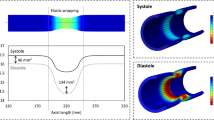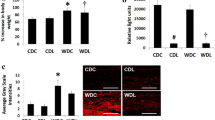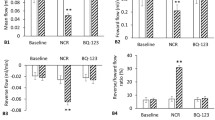Abstract
Purpose
Metabolic syndrome patients exhibit impaired cholesterol efflux capacity. Previous studies have shown a positive association between aortic stiffness and metabolic syndrome. However, it is unknown whether cholesterol efflux capacity participates in the process of aortic stiffness. This study sought to determine the effect of metabolic syndrome on aortic stiffening, and to investigate the effectiveness of aortic wraps on aortic compliance and the underlying mechanisms.
Methods
In a swine model of metabolic syndrome, we compared the cholesterol efflux capacity and aortic compliance responding to diet modifications and aortic wrap applications.
Results
Metabolic syndrome induced by high cholesterol diet significantly decreased cholesterol efflux capacity and aortic compliance. Elastic aortic wrap application increased aortic compliance and partially restored cholesterol efflux capacity via ATP binding cassette transporter A1 (ABCA1) pathway.
Conclusions
Cholesterol efflux plays a role in aortic stiffening. Elastic aortic wrap application could be a potential treatment for aortic stiffness related to metabolic syndrome.


Similar content being viewed by others
Abbreviations
- Apo:
-
Apolipoprotein (Apo)
- ABCA1:
-
ATP binding cassette transporter A1
- ABCG1:
-
ATP binding cassette transporter G1
- EF:
-
Ejection fraction
- LVEDV:
-
Left ventricular end diastolic volume
- LVESV:
-
Left ventricular end systolic volume
- PSEM:
-
Pressure-strain elastic modulus
- SR-BI:
-
Scavenger receptor class B, type I
- TEE:
-
Transesophageal echocardiography
References
Ballantyne CM, Hoogeveen RC, McNeill AM, Heiss G, Schmidt MI, Duncan BB, et al. Metabolic syndrome risk for cardiovascular disease and diabetes in the ARIC study. Int J Obes (Lond). 2008;32(Suppl 2):S21–4. https://doi.org/10.1038/ijo.2008.31.
Vagovicova P, Mlikova Seidlerova J, Mayer O Jr, Wohlfahrt P, Cifkova R, Filipovsky J. Differential effect of metabolic syndrome on various parameters of arterial stiffness. Blood Press. 2015;24(4):206–11. https://doi.org/10.3109/08037051.2015.1049420.
Scuteri A, Cunha PG, Rosei EA, Badariere J, Bekaert S, Cockcroft JR, et al. Arterial stiffness and influences of the metabolic syndrome: a cross-countries study. Atherosclerosis. 2014;233(2):654–60. https://doi.org/10.1016/j.atherosclerosis.2014.01.041.
Ferreira I, Boreham CA, Twisk JW, Gallagher AM, Young IS, Murray LJ, et al. Clustering of metabolic syndrome risk factors and arterial stiffness in young adults: the Northern Ireland young hearts project. J Hypertens. 2007;25(5):1009–20. https://doi.org/10.1097/HJH.0b013e3280a94e76.
Stehouwer CD, Henry RM, Ferreira I. Arterial stiffness in diabetes and the metabolic syndrome: a pathway to cardiovascular disease. Diabetologia. 2008;51(4):527–39. https://doi.org/10.1007/s00125-007-0918-3.
Gall J, Frisdal E, Bittar R, Le Goff W, Bruckert E, Lesnik P, et al. Association of Cholesterol Efflux Capacity With Clinical Features of Metabolic Syndrome: Relevance to Atherosclerosis. J Am Heart Assoc. 2016;5(12) https://doi.org/10.1161/jaha.116.004808.
Fu Y. Rate-limiting factors of cholesterol efflux in reverse cholesterol transport: acceptors and donors. Clin Exp Pharmacol Physiol. 2010;37(7):703–9. https://doi.org/10.1111/j.1440-1681.2010.05386.x.
Cavelier C, Lorenzi I, Rohrer L, von Eckardstein A. Lipid efflux by the ATP-binding cassette transporters ABCA1 and ABCG1. Biochim Biophys Acta. 2006;1761(7):655–66. https://doi.org/10.1016/j.bbalip.2006.04.012.
Liao S, McLachlan CS. Cholesterol Efflux: Does It Contribute to Aortic Stiffening? J Cardiovasc Dev Dis. 2018;5(2) https://doi.org/10.3390/jcdd5020023.
Vaisman BL, Demosky SJ, Stonik JA, Ghias M, Knapper CL, Sampson ML, et al. Endothelial expression of human ABCA1 in mice increases plasma HDL cholesterol and reduces diet-induced atherosclerosis. J Lipid Res. 2012;53(1):158–67. https://doi.org/10.1194/jlr.M018713.
Westerterp M, Tsuchiya K, Tattersall IW, Fotakis P, Bochem AE, Molusky MM, et al. Deficiency of ATP-binding cassette transporters A1 and G1 in endothelial cells accelerates atherosclerosis in mice. Arterioscler Thromb Vasc Biol. 2016;36(7):1328–37. https://doi.org/10.1161/atvbaha.115.306670.
Castiglioni S, Monti M, Arnaboldi L, Canavesi M, Ainis Buscherini G, Calabresi L, et al. ABCA1 and HDL3 are required to modulate smooth muscle cells phenotypic switch after cholesterol loading. Atherosclerosis. 2017;266:8–15. https://doi.org/10.1016/j.atherosclerosis.2017.09.012.
Bi X, Vitali C, Cuchel M. ABCA1 and inflammation: from animal models to humans. Arterioscler Thromb Vasc Biol. 2015;35(7):1551–3. https://doi.org/10.1161/atvbaha.115.305547.
Cavalcante JL, Lima JA, Redheuil A, Al-Mallah MH. Aortic stiffness: current understanding and future directions. J Am Coll Cardiol. 2011;57(14):1511–22. https://doi.org/10.1016/j.jacc.2010.12.017.
Vlachopoulos C, Aznaouridis K, Stefanadis C. Prediction of cardiovascular events and all-cause mortality with arterial stiffness: a systematic review and meta-analysis. J Am Coll Cardiol. 2010;55(13):1318–27. https://doi.org/10.1016/j.jacc.2009.10.061.
Mitchell GF, Hwang SJ, Vasan RS, Larson MG, Pencina MJ, Hamburg NM, et al. Arterial stiffness and cardiovascular events: the Framingham heart study. Circulation. 2010;121(4):505–11. https://doi.org/10.1161/circulationaha.109.886655.
Janic M, Lunder M, Sabovic M. Arterial stiffness and cardiovascular therapy. Biomed Res Int. 2014;2014:621437–11. https://doi.org/10.1155/2014/621437.
Giudici F, Qian Y, O'Rourke M, Avolio A. Simulation of reduction of proximal aortic stiffness by an elastic wrap and effects on pulse pressure. Conf Proc IEEE Eng Med Biol Soc. 2012;2012:657–60. https://doi.org/10.1109/embc.2012.6346017.
Robich MP, Osipov RM, Chu LM, Han Y, Feng J, Nezafat R, et al. Resveratrol modifies risk factors for coronary artery disease in swine with metabolic syndrome and myocardial ischemia. Eur J Pharmacol. 2011;664(1–3):45–53. https://doi.org/10.1016/j.ejphar.2011.04.059.
Saraf R, Huang T, Mahmood F, Owais K, Bardia A, Khabbaz KR, et al. Early cellular changes in the ascending aorta and myocardium in a swine model of metabolic syndrome. PLoS One. 2016;11(1):e0146481. https://doi.org/10.1371/journal.pone.0146481.
Roldan CA, Alomari IB, Awad K, Boyer NM, Qualls CR, Greene ER, et al. Aortic stiffness is associated with left ventricular diastolic dysfunction in systemic lupus erythematosus: a controlled transesophageal echocardiographic study. Clin Cardiol. 2014;37(2):83–90. https://doi.org/10.1002/clc.22218.
Iliopoulos J. The aortic wrap procedure: a surgical method of treating age related aortic dilatation and stiffening [dissertation]. Sydney: University of New South Wales; 2006.
Tropea BI, Schwarzacher SP, Chang A, Asvar C, Huie P, Sibley RK, et al. Reduction of aortic wall motion inhibits hypertension-mediated experimental atherosclerosis. Arterioscler Thromb Vasc Biol. 2000;20(9):2127–33.
Li XM, Tang WH, Mosior MK, Huang Y, Wu Y, Matter W, et al. Paradoxical association of enhanced cholesterol efflux with increased incident cardiovascular risks. Arterioscler Thromb Vasc Biol. 2013;33(7):1696–705. https://doi.org/10.1161/atvbaha.113.301373.
Favari E, Calabresi L, Adorni MP, Jessup W, Simonelli S, Franceschini G, et al. Small discoidal pre-beta1 HDL particles are efficient acceptors of cell cholesterol via ABCA1 and ABCG1. Biochemistry. 2009;48(46):11067–74. https://doi.org/10.1021/bi901564g.
Villard EF, El Khoury P, Duchene E, Bonnefont-Rousselot D, Clement K, Bruckert E, et al. Elevated CETP activity improves plasma cholesterol efflux capacity from human macrophages in women. Arterioscler Thromb Vasc Biol. 2012;32(10):2341–9. https://doi.org/10.1161/atvbaha.112.252841.
Low H, Hoang A, Sviridov D. Cholesterol efflux assay. J Vis Exp. 2012;61:e3810. https://doi.org/10.3791/3810.
Boutouyrie P, Fliser D, Goldsmith D, Covic A, Wiecek A, Ortiz A, et al. Assessment of arterial stiffness for clinical and epidemiological studies: methodological considerations for validation and entry into the European renal and cardiovascular medicine registry. Nephrol Dial Transplant. 2014;29(2):232–9. https://doi.org/10.1093/ndt/gft309.
Park S, Lakatta EG. Role of inflammation in the pathogenesis of arterial stiffness. Yonsei Med J. 2012;53(2):258–61. https://doi.org/10.3349/ymj.2012.53.2.258.
Emre A, Oz D, Yesilcimen K, Sayar N, Ergun D. Impact of the metabolic syndrome on aortic pulse pressure and ascending aortic pulsatility in patients with angiographically normal coronary arteries. Can J Cardiol. 2009;25(7):411–4.
Annema W, Dikkers A, de Boer JF, van Greevenbroek MM, van der Kallen CJ, Schalkwijk CG, et al. Impaired HDL cholesterol efflux in metabolic syndrome is unrelated to glucose tolerance status: the CODAM study. Sci Rep. 2016;6:27367. https://doi.org/10.1038/srep27367.
Borja MS, Hammerson B, Tang C, Savinova OV, Shearer GC, Oda MN. Apolipoprotein A-I exchange is impaired in metabolic syndrome patients asymptomatic for diabetes and cardiovascular disease. 2017;12(8):e0182217. https://doi.org/10.1371/journal.pone.0182217.
Khera AV, Cuchel M, de la Llera-Moya M, Rodrigues A, Burke MF, Jafri K, et al. Cholesterol efflux capacity, high-density lipoprotein function, and atherosclerosis. N Engl J Med. 2011;364(2):127–35. https://doi.org/10.1056/NEJMoa1001689.
Dubland JA, Francis GA. So much cholesterol: the unrecognized importance of smooth muscle cells in atherosclerotic foam cell formation. Curr Opin Lipidol. 2016;27(2):155–61. https://doi.org/10.1097/mol.0000000000000279.
Prosser HC, Ng MK, Bursill CA. The role of cholesterol efflux in mechanisms of endothelial protection by HDL. Curr Opin Lipidol. 2012;23(3):182–9. https://doi.org/10.1097/MOL.0b013e328352c4dd.
Munch G, Bultmann A, Li Z, Holthoff HP, Ullrich J, Wagner S, et al. Overexpression of ABCG1 protein attenuates arteriosclerosis and endothelial dysfunction in atherosclerotic rabbits. Heart Int. 2012;7(2):e12. https://doi.org/10.4081/hi.2012.e12.
Liu D, Ji L, Tong X, Pan B, Han JY, Huang Y, et al. Human apolipoprotein A-I induces cyclooxygenase-2 expression and prostaglandin I-2 release in endothelial cells through ATP-binding cassette transporter A1. Am J Phys Cell Physiol. 2011;301(3):C739–48. https://doi.org/10.1152/ajpcell.00055.2011.
Bochem AE, van Wijk DF, Holleboom AG, Duivenvoorden R, Motazacker MM, Dallinga-Thie GM, et al. ABCA1 mutation carriers with low high-density lipoprotein cholesterol are characterized by a larger atherosclerotic burden. Eur Heart J. 2013;34(4):286–91. https://doi.org/10.1093/eurheartj/ehs376.
van Dam MJ, de Groot E, Clee SM, Hovingh GK, Roelants R, Brooks-Wilson A, et al. Association between increased arterial-wall thickness and impairment in ABCA1-driven cholesterol efflux: an observational study. Lancet. 2002;359(9300):37–42. https://doi.org/10.1016/s0140-6736(02)07277-x.
Favari E, Ronda N, Adorni MP, Zimetti F, Salvi P, Manfredini M, et al. ABCA1-dependent serum cholesterol efflux capacity inversely correlates with pulse wave velocity in healthy subjects. J Lipid Res. 2013;54(1):238–43. https://doi.org/10.1194/jlr.P030452.
Mourmoura E, Vasilaki A, Giannoukas A, Michalodimitrakis E, Pavlidis P, Tsezou A. Evidence of deregulated cholesterol efflux in abdominal aortic aneurysm. Acta Histochem. 2016;118(2):97–108. https://doi.org/10.1016/j.acthis.2015.11.012.
Aiello RJ, Brees D, Francone OL. ABCA1-deficient mice: insights into the role of monocyte lipid efflux in HDL formation and inflammation. Arterioscler Thromb Vasc Biol. 2003;23(6):972–80. https://doi.org/10.1161/01.atv.0000054661.21499.fb.
Tang C, Liu Y, Kessler PS, Vaughan AM, Oram JF. The macrophage cholesterol exporter ABCA1 functions as an anti-inflammatory receptor. J Biol Chem. 2009;284(47):32336–43. https://doi.org/10.1074/jbc.M109.047472.
Babashamsi MM, Halalkhor S, Moradi Firouzjah H, Parsian H, Jalali SF, Babashamsi M. Association of ATP-binding cassette transporter A1 (ABCA1)-565 C/T gene polymorphism with Hypoalphalipoproteinemia and serum lipids, IL-6 and CRP levels. Avicenna J Med Biotechnol. 2017;9(1):38–43.
Li C, Guo R, Lou J, Zhou H. The transcription levels of ABCA1, ABCG1 and SR-BI are negatively associated with plasma CRP in Chinese populations with various risk factors for atherosclerosis. Inflammation. 2012;35(5):1641–8. https://doi.org/10.1007/s10753-012-9479-9.
Xu M, Zhou H, Gu Q, Li C. The expression of ATP-binding cassette transporters in hypertensive patients. Hypertens Res. 2009;32(6):455–61. https://doi.org/10.1038/hr.2009.46.
Chawla A, Boisvert WA, Lee CH, Laffitte BA, Barak Y, Joseph SB, et al. A PPAR gamma-LXR-ABCA1 pathway in macrophages is involved in cholesterol efflux and atherogenesis. Mol Cell. 2001;7(1):161–71.
Ameshima S, Golpon H, Cool CD, Chan D, Vandivier RW, Gardai SJ, et al. Peroxisome proliferator-activated receptor gamma (PPARgamma) expression is decreased in pulmonary hypertension and affects endothelial cell growth. Circ Res. 2003;92(10):1162–9. https://doi.org/10.1161/01.res.0000073585.50092.14.
Bigazzi F, Adorni MP, Puntoni M, Sbrana F, Lionetti V, Pino BD, et al. Analysis of serum cholesterol efflux capacity in a Minipig model of nonischemic heart failure. J Atheroscler Thromb. 2017;24(8):853–62. https://doi.org/10.5551/jat.37101.
Zhu M, Fu Y, Hou Y, Wang N, Guan Y, Tang C, et al. Laminar shear stress regulates liver X receptor in vascular endothelial cells. Arterioscler Thromb Vasc Biol. 2008;28(3):527–33. https://doi.org/10.1161/atvbaha.107.143487.
Walldius G, Jungner I, Holme I, Aastveit AH, Kolar W, Steiner E. High apolipoprotein B, low apolipoprotein A-I, and improvement in the prediction of fatal myocardial infarction (AMORIS study): a prospective study. Lancet. 2001;358(9298):2026–33. https://doi.org/10.1016/s0140-6736(01)07098-2.
Tian L, Wu X, Fu M, Qin Y, Xu Y, Jia L. Relationship between plasma apolipoproteinB concentrations, apolipoproteinB/apolipoproeinA-I and HDL subclasses distribution. Clin Chim Acta. 2008;388(1–2):148–55. https://doi.org/10.1016/j.cca.2007.10.028.
Corsetti JP, Zareba W, Moss AJ, Sparks CE. Apolipoprotein B determines risk for recurrent coronary events in postinfarction patients with metabolic syndrome. Atherosclerosis. 2004;177(2):367–73. https://doi.org/10.1016/j.atherosclerosis.2004.07.019.
Heinecke JW. The not-so-simple HDL story: a new era for quantifying HDL and cardiovascular risk? Nat Med. 2012;18(9):1346–7. https://doi.org/10.1038/nm.2930.
Marcovina S, Packard CJ. Measurement and meaning of apolipoprotein AI and apolipoprotein B plasma levels. J Intern Med. 2006;259(5):437–46. https://doi.org/10.1111/j.1365-2796.2006.01648.x.
Kim MK, Ahn CW, Kang S, Ha JY, Baek H, Park JS, et al. Association between Apolipoprotein B/Apolipoprotein A-1 and arterial stiffness in metabolic syndrome. Clin Chim Acta. 2014;437:115–9. https://doi.org/10.1016/j.cca.2014.07.005.
Acknowledgments
The authors gratefully acknowledge the financial support from The Limingzhang Sciences Foundation (2016-451903). Shutan Liao is funded under an NHMRC Development Grant.
Author information
Authors and Affiliations
Corresponding author
Ethics declarations
The study protocol was approved by the Animal Ethics Committee of Nanchang University.
Conflict of interest
The authors declare that they have no conflict of interest.
Disclosures
All authors have reported that they have no relationships relevant to the contents of this paper to disclose.
Rights and permissions
About this article
Cite this article
Liao, S., Zhou, Q. & Zhang, Y. Elastic aortic wrap reduced aortic stiffness by partially alleviating the impairment of cholesterol efflux capacity in pigs. J Diabetes Metab Disord 17, 101–109 (2018). https://doi.org/10.1007/s40200-018-0345-7
Received:
Accepted:
Published:
Issue Date:
DOI: https://doi.org/10.1007/s40200-018-0345-7




